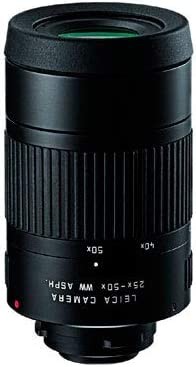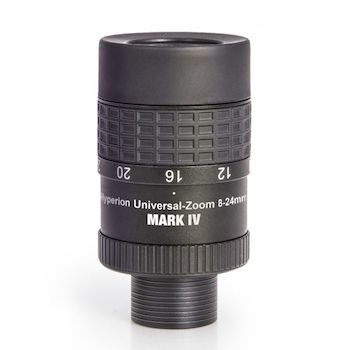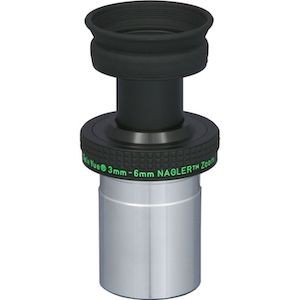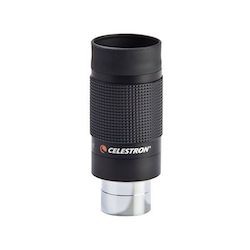Zoom telescope eyepieces are often recommended for beginner astronomers as a tool to achieve varying magnifications. These versatile accessories, equipped with the capacity to change focal lengths, offer a dynamic viewing experience unlike any other. However, not all zoom eyepieces are created equal, and one may or may not be what you need for your telescope. Like all astronomy equipment, zoom eyepieces have their strengths and limitations. While their versatility is unparalleled, potential users should be aware of certain drawbacks, such as potential optical quality trade-offs, restricted fields of view at lower magnifications, and a high cost compared to normal, high-quality oculars.
Zoom eyepieces, of course, allow you to achieve any magnification within their specified focal length range. However, the fundamental ways in which zoom eyepieces operate place limitations on them. Zoom eyepieces usually work like a telephoto lens, moving internal magnifying lens groups to increase or decrease focal length. At the long end of a zoom eyepiece’s focal length, the apparent field of view can get narrow, and refocusing is required when making adjustments. The field of view is rarely, if ever, constant, either. The large number of lenses usually used in a zoom eyepiece can often mean they provide a dimmer and less crisp image than an eyepiece with a fixed focal length, especially if they are cheaply made.
Zoom eyepieces are definitely a compromise. They are never going to be the sharpest eyepieces you can get for your money. They are, however, useful if you are trying to figure out the ideal magnification for an object. They are also ideal for astronomy outreach with other people, where you may want the ability to quickly switch magnifications and/or minimize the risk of damage to multiple eyepieces from accidents.
You might benefit from getting a zoom eyepiece if you fit one or more of the following:
- Use a telescope with a focal ratio of f/6 or slower
- Want to buy a pair of zoom eyepieces for use in a binoviewer
- Do a lot of astronomy outreach
You probably won’t like a zoom eyepiece if you fit one or more of the following:
- Want wide-angle views at low magnifications
- Use a telescope with a focal ratio faster than f/6
- Want the sharpest possible views of planets and other high-resolution targets
- Observe in cold weather, which can make the zoom mechanism too stiff to easily adjust
Zoom Eyepieces or Barlow Lens?
A zoom eyepiece should at least have several click-stop settings for different focal lengths, usually around 4. A Barlow lens and a pair of eyepieces would give you the same number of magnification options and might give you significantly sharper views as well as other benefits. The trade-off is that a good Barlow and a pair of good eyepieces could end up costing a lot more than a zoom, and of course they’ll take up three times as much space as a zoom eyepiece.
Zoom Eyepieces to Avoid
Cheap 7-21mm zoom eyepieces have issues with requiring precise eye placement to avoid “blackout” when looking through them at low power, and at the 21mm setting, the apparent field of view is only 30 degrees, feeling much like a drinking straw to look through, and expanding to a claustrophobic 43 degrees at the 7mm setting. These eyepieces also perform poorly in telescopes faster than f/8 or so, with numerous sharpness, chromatic aberration, and off-axis aberration issues. There are quality control issues with these eyepieces too.
The cheap 8-24mm “goldline” zoom designs often sold for under $50 USD have extremely narrow fields of view, loads of chromatic aberration and field curvature, little eye relief, and often quality control issues like dust particles and internal rattle. They are pretty much only useful as kids’ toys.
Best Zoom Eyepieces – Our Recommendations
1. Best Performance Zoom Eyepiece – Leica ASPH 8.9-17.8mm Zoom

This eyepiece has a wide apparent field of view, ranging from 60 degrees at the 17.8mm setting to 80 degrees at the 8.9mm setting. The eye relief is also excellent, making it easy to look through even if you have to wear glasses. The correction is good down to f/4. Below f/4, this eyepiece has too much edge-of-field astigmatism and curvature to be used even with a coma corrector, but few are likely to have such a fast instrument. Originally intended as a spotting scope eyepiece, the ASPH will require a specially made 1.25” or 2” adapter for use in a telescope. Of course, the price is quite high, to the point where buying a set of well-corrected premium ultra-wide angle eyepieces is actually cheaper.
2. Best Value Zoom Eyepiece – Baader Hyperion Mark IV 8-24mm Zoom

The Baader Hyperion Mark IV 8-24mm Zoom can be used as a 1.25” or 2” eyepiece and features an apparent field of 68 degrees at 8mm to 50 degrees at 24mm, or comparable to wide-angle and Plossl eyepieces. 50 degrees is about as narrow as is generally considered comfortable or acceptable nowadays. Correction towards the edges of the field of view is great at f/8 and acceptable down to f/5, at which point sharpness towards the edge of the field of view drops dramatically. Like the Leica ASPH, Baader offers a dedicated Barlow lens for this eyepiece.
3. Best Planetary Zoom Eyepiece – TeleVue Nagler 3-6mm Zoom

The Nagler Zoom is different from most zooms because it has a constant 50-degree apparent field and stays in focus even as the barrel extends. This eyepiece will be razor-sharp in any telescope. However, a mere 10mm of eye relief makes it a bit uncomfortable to look through and nearly impossible to use with glasses.
4. Best Cheap Zoom Eyepiece – Celestron 8-24mm Zoom

The Celestron 8-24mm Zoom has a narrow field of only 40 degrees at its 24mm setting, increasing to 60 degrees at 8mm. This eyepiece is not exactly “premium” and has some chromatic aberration as well as issues with sharpness in telescopes below f/6 to f/7. However, it’s great for astronomy outreach or binoviewing as it’s comfortable to look through and a lot less expensive than other offerings.
Other Zoom Eyepieces to Consider
- The Pentax XL 8-24mm SMC Waterproof Zoom is gigantic, dwarfing many eyepieces though still working in a 1.25” barrel. Using the Pentax XL may be a problem if you have a small telescope due to the sheer weight of this eyepiece. It has an apparent field of view ranging from 60 degrees at 8mm to 38 degrees at 24mm. In addition to being waterproof, the Pentax XL 8-24mm is extremely sharp and works well down to f/5 or so.
- The Pentax XF 6.5mm-19.5mm XF Zoom has an apparent field varying from 42 degrees at 19.5mm to 60 degrees at 6.5mm. It is sharp in telescopes slower than f/7 but has severe issues with field curvature and chromatic aberration in faster instruments. It’s also rather short on eye relief. For the price, it probably isn’t worth purchasing if you can get your hands on the Baader Hyperion Zoom instead.
Zoom Eyepiece Pros
- Flexibility
The primary advantage of a zoom eyepiece is its ability to provide a range of magnifications within a single piece of equipment. By simply adjusting the zoom setting, you can alter the eyepiece’s focal length, allowing you to move from a wider view of the sky to close-up views of celestial bodies without the need to switch eyepieces. Zoom eyepieces’ flexibility also proves beneficial when tracking moving satellites or terrestrial objects like birds and aircraft, as it allows for easy adjustments to your view.
- Convenience
Zoom eyepieces reduce the need for multiple eyepieces for different magnifications. This makes them highly portable and convenient, particularly for observational sessions where mobility is crucial or where quick changes in magnification are desirable. This also means that you can avoid eyepiece swaps when showing views to others, and you’re only putting a single ocular at risk of theft or damage at an outreach event, which can obviate a bulky and easily misplaced or stolen eyepiece case.
- Cost
When compared to purchasing multiple eyepieces of comparable quality, a single zoom eyepiece is often more cost-effective. It’s an attractive option for those keen on maximizing value while minimizing expenses. This becomes even more true if you are using a binoviewer and need 2 of each eyepiece. A pair of zoom eyepieces is a lot cheaper than several pairs of high-quality eyepieces.
Zoom Eyepiece Cons
- Optical Quality
One of the most significant drawbacks of zoom eyepieces, particularly those targeted at beginners or available at a lower price point, is the potential compromise on optical quality. When compared to their fixed focal length counterparts, zoom eyepieces may exhibit off-axis aberrations – as you move away from the center of the eyepiece, you might encounter distorted images, reducing the clarity of peripheral celestial objects. Chromatic aberration, as well as glare and ghost images, also plague cheaper units.
Zoom eyepieces are also not particularly useful in telescopes with fast focal ratios. They are typically not designed for good performance with the shallow angles of fast f/ratio telescopes’ light cones, and the varying spacing of the internal lenses means it is basically impossible for them to achieve good correction across the entire range of focal lengths.
- Inconsistent field of view
While zoom eyepieces offer a wide apparent field of view at their shorter focal length range and high magnifications, this often significantly narrows as you increase the focal length and back off the magnification. In contrast, most high-quality fixed focal length eyepieces maintain a wide apparent field of view.
- Inconsistent focus and eye relief
Most zooms still require you to adjust the focus between focal length changes, whereas many eyepiece sets are parfocal with each other even though you have to swap out oculars for different magnifications. Many zooms also change in eye relief as you adjust focal length. These factors are both just consequences of the optical design of most zooms.

Relative quality of view of the Celestron 8-24mm zoom compared with the Kellner 10 & 20mm eyepieces that come stock with the Orion Skyscanner 100mm? Considering the F4 focal ratio of the Skyscanner. Concerned after reading this article. Debating between a Goldline 9mm and decent 2x Barlow vs. the zoom.
Posted a similar question at the Celestron 8-24mm review article. Just found this article. Sorry.
I would not recommend the zoom with that scope, it will be pretty bad at f/4
I’m thinking of the Baader zoom mark iv for my celestron evolution 6″ f/10., thoughts?
Good choice but you’ll want something shorter than 8mm (or a Barlow) and to keep the provided 40mm handy for maximum true field.
Is the Svbony 7-21 mm zoom any good? It’s cheaper than the celestron but seems to get some good reviews.
Not particularly, the more well-known 8-24mm zooms are sharper and offer a wider FOV.